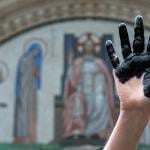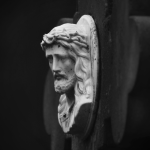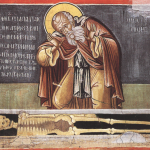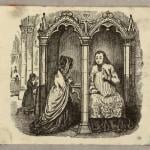MODERN NATURE: Derek Jarman’s autobiographies. Which I’m re-reading for work-related reasons. What follows is even more scattered than most of my posts.
LATE NIGHT, MAUDLIN STREET. A bit of background: Jarman seriously damaged my writing, when I was in high school. Admittedly, if he hadn’t done it someone else would have! But, for whatever reason, he was one of the people I tried to emulate. This is not recommended.
When he died my best friend and I put up posters around the school with his picture, and text reading THE LAST OF ENGLAND or PREMATURE BURIAL.
Something about who he was hooked into something about who we were.
HOSPITAL VESPERS. It is bracing and necessary for those of us in the post-1965 (let’s say) demographic to read AIDS memoirs; which is what these often are. I don’t have any good way of describing what Jarman details–the constant, daily news that this friend is sick, that friend is worse, this man is dead. What it’s like to build your life around a group of people who are dead or terminally ill before they turn thirty. Like I said–I don’t have words for it. Just read something from someone who was there. (…And the Band Played On, while worthwhile in its own way, is perched too high above the devastation to do the kind of work I’m thinking of. ATBPO is about reasons for epidemic; and reasons aren’t the only thing that matter in the wake of destruction.)
STICKY UNDER THE COLLAR IN ELSINORE. I was struck by how obsessively Jarman returned to the canonical Western culture–and how unable he was to see anything in it other than homosexuality and the beauty of nature. Shakespeare, Caravaggio, Britten, Marlowe, Wittgenstein: Yeah, you can go there if you want, but they cover so much more in their actual works than Jarman did in his. I was especially struck by Jarman’s focus on Christian imagery and iconography: It never goes anywhere or demands anything of the gay viewer. He’s obsessively drawn to the Church but can’t make it interesting. Which… yeah, if my only contact with Catholicism were through my horrible boarding school, I would likely go the same route. But it makes all of his films seem half-formed, almost: a collision between strong imagery and weak theory.
ALL I ASK OF YOU IS THE ONE THING THAT YOU’LL NEVER DO. In Jarman’s autobiographies, he allows no hint of ambivalence about the rightness of homosexual acts.
So I wonder why he keeps returning to the subject, and especially to the imagery of the Church. His family wasn’t Catholic (although it sounds like the Horrible Boarding School was). But what drew him back to those images, again and again? Why couldn’t he find anything in them besides the usual repression vs. liberation trope?
Why not leave it all behind? Is it just that the Church had deep, nefarious influence in Margaret Thatcher’s England? That seems insufficient for someone as committed as Jarman to art for its own sake. He saw art much the way I do: enmeshed in the politics of its time (because enmeshed in philosophy), but also existing on its own, concerned with neglected beauty and the joys this world promises but can’t deliver. So why did Jarman think the Catholic Church provided so much fodder for his vision?
I have my answer; I don’t think the Church is just les fleurs du mal. (I got over that idea in approx. January 2001.) But what is so intriguing to me is that Jarman neither poses nor answers the question, ever.











